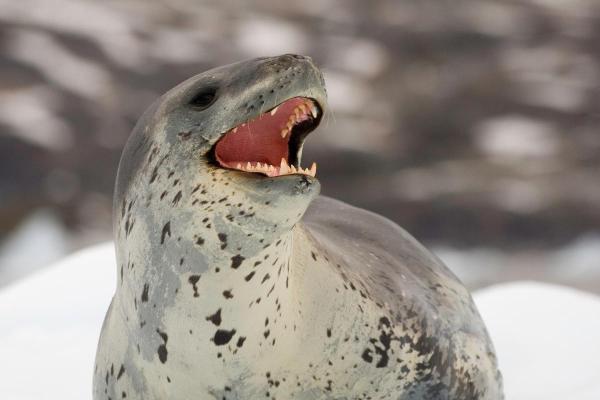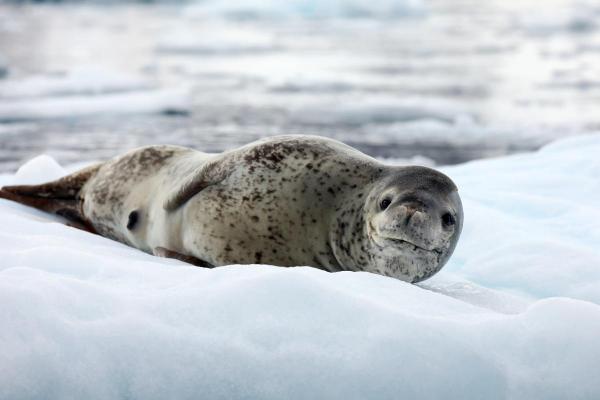
The leopard seal (Hydrurga leptonyx) is well adapted to its habitat, living both on land and sea. It has adapted limbs known as flippers which allow the animal to both swim gracefully in the water and walk not so gracefully on land. Their powerful jaws make them adept hunters, catching fish, cephalopods, penguins and other aquatic animals. Other adaptations include a thick layer of blubber which keeps them protected from the often freezing cold waters they inhabit. This can give us some idea of the question AnimalWised asks where do leopard seals live?
Leopard seals live primarily in Antarctica, spending much of their time on ice floes and pack ice in the region. They also live in other waters. We explain more about leopard seal population distribution and their habitats.
Characteristics of leopard seals
Leopard seals are true seals, meaning they belong to the Phocidae family. Their name comes from their mottled fur, similar to that of the big cat species known as a leopard. Their skin presents in dark spots on a silvery-gray background. They have an elongated and streamlined body, perfectly adapted for moving quickly in the water. While their flippers help them swim proficiently, they can be more cumbersome and awkward on land.
Females are larger than males, reaching lengths of 9.8-12.4 ft (3-3.8 m) and weights of up to 1100 lb (500 kg). Males tend to measure between 9.1-10.8 ft (2.8-3.3 m) and weigh up to 881 lb (400 kg). One of their most distinctive features is their powerful jaw which is equipped with long and sharp teeth. These allow leopard seals to capture and tear apart slippery prey such as penguins and even other seals.
Leopard seals also have a thick layer of subcutaneous fat known as blubber that protects them from the frigid temperatures of the Southern Ocean. Unlike other seals, leopard seals are solitary and highly territorial animals, except during mating season.
Discover more about the general characteristics of seals with our article asking do seals have claws on their flippers?
Where do leopard seals live?
Leopard seals primarily inhabit the cold waters of the Antarctic ice pack, although some individuals migrate to the Southern Ocean during the winter. Their geographic distribution includes the coasts of Antarctica, as well as nearby islands such as:
- South Georgia
- The Southern Sandwich Islands
They prefer areas with sea ice. This is because they can use them to rest, mate and even stalk their prey from floating ice shelves. Unlike other types of seal species, they do not form large colonies and tend to be solitary animals, except during breeding seasons. Their ability to adapt to different conditions allows them to explore more remote areas, although they always maintain a strong association with polar environments.
What do leopard seals eat?
Leopard seals are versatile and opportunistic predators with a varied diet. This diet depends largely on the availability of prey in their environment. One of their favorite foods is penguins, especially the emperor penguin and the Adélie penguin. They stalk these flightless birds near the edges of the ice to capture with quick, precise and deadly movements.
In addition to penguins, they also hunt other seals. They appear to be particularly fond of crabeater seal pups. Their technique consists of grabbing them by the flippers and violently shaking them in the water until they are dead. When large prey is scarce, they occasionally supplement their diet with krill, fish and squid, using their strong jaws to crush the soft bodies of these animals.

Is the leopard seal dangerous?
The leopard seal is considered one of the most dangerous predators in the Southern Ocean to its prey. Although incidences of direct contact are rare, they can also be dangerous to humans. The curious and aggressive nature of the leopard seal makes it unpredictable, especially when it feels threatened or when it detects movement in the water.
Leopard seals have been reported to have bitten divers or researchers, although these incidents are rarely fatal. Unlike other seals, such as the harbor seal, which tend to be more docile, leopard seals are more territorial and can display hostile behavior if their space is invaded. For this reason, it is recommended to maintain a safe distance and avoid interacting with them in their natural habitat.
What animals eat leopard seals?
We have spoken about the animals which they eat, but there are other animals which can see leopard seals as prey. Despite being top predators in their environment, leopard seals are not exempt from threats. Their main predator is the killer whale (Orcinus orca). This type of large dolphin can hunt them in open water thanks to their pack behavior and strategic intelligence.
In subantarctic areas, large sharks like the great white shark also pose a danger, especially to young or sick individuals. Furthermore, climate change and the decline of sea ice are affecting their habitat. This could alter the availability of their prey and expose them to greater risks.
Unlike other seal species, leopard seals are not actively hunted by humans. They do face indirect risks such as marine pollution and bycatch.

How do leopard seals reproduce?
Leopard seal reproduction follows an annual cycle marked by the Antarctic seasons. Mating occurs during the southern hemisphere summer, lasting between December and January. The mating act itself usually takes place in the water. Unlike other seals, males do not form harems, but compete with each other for access to females.
Gestation of leopard seal pups lasts approximately 11 months. They can also carry out delayed implantation that allows the birth of the young to be synchronized with the most favorable environmental conditions. Females give birth on ice shelves between September and November, usually to a single pup.
Mothers nurse their young for a month, during which time they protect them and teach them basic survival skills. After this time, the young must learn to hunt on their own. Females reach sexual maturity between 3 and 7 years of age, while males do so between 6 and 7 years of age.
If you want to read similar articles to Where Do Leopard Seals Live?, we recommend you visit our Facts about the animal kingdom category.
- Hall-Aspland, S. A., & Rogers, T. L. (2004). Summer diet of leopard seals (Hydrurga leptonyx) in Prydz Bay, Eastern Antarctica. Polar Biology, 27, 729-734.
- Rogers, T. L. (2009). Leopard pointed out: Hydrurga leptonyx. In Encyclopedia of Marine Mammals (pp. 673-674). Academic Press.
- van der Linde, K., Visser, I. N., Bout, R., Krause, D. J., Forcada, J., Siniff, D.,... & Cooper, T. E. (2022). A review of leopard seal (Hydrurga leptonyx) births and pups using a standardized age-class classification system. Polar Biology, 45(7), 1193-1209.